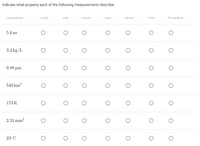
Chemistry
10th Edition
ISBN: 9781305957404
Author: Steven S. Zumdahl, Susan A. Zumdahl, Donald J. DeCoste
Publisher: Cengage Learning
expand_more
expand_more
format_list_bulleted
Concept explainers
Question
thumb_up100%

Transcribed Image Text:Indicate what property each of the following measurements describe:
Measurement
Length
Area
Volume
Mass
Density
Time
Temperature
5.6 ns
3.2 kg/L
0.88 pm
540 km?
173 K
2.31 mm3
23°C
Expert Solution
This question has been solved!
Explore an expertly crafted, step-by-step solution for a thorough understanding of key concepts.
This is a popular solution
Trending nowThis is a popular solution!
Step by stepSolved in 2 steps

Knowledge Booster
Learn more about
Need a deep-dive on the concept behind this application? Look no further. Learn more about this topic, chemistry and related others by exploring similar questions and additional content below.Similar questions
- Which of the following is an example of a physical property of a substance? The substance reacts violently with water. The substance melts at 73.59 oC. The substance was named after a 3rd century AD African philosopher. The substance is used as a tranquilizer. If a reaction or process is exothermic, Heat or energy is neither going into or out of the reaction or process. Heat or energy is going out of the reaction or process. None of these answers. Heat or energy is going into the reaction or process. Which of the following is a chemical property of a substance? The substance reacts violently with hydrogen, producing a green powder. The substance is a bright orange color. The substance melts at 373.3 degrees Celcius. The density of the substance is 3.375 g/ml. Which of the following is a part of quantum mechanics? The smallest indivisible particles of a substance are atoms. The electrons exist as small bits of negative charge existing in…arrow_forwardA student sets up the following equation to convert a measurement. (The ? stands for a number the student is going to calculate.) Fill in the missing part of this equation. (54. cm).= ? kmarrow_forwardComplete the following non-metric conversions using the table of conversions in the slides. Remember to express your answer to the correct number of significant digits. Include only your numerical answers without units. Convert 1.730 lbs to kg Convert 53.11 in to m Convert 3.85 gal to L Convert 113.47 J to cal [a] kg [b] m [C] L [d] calarrow_forward
- In the summer, the outdoor temperature in the Northeast might be 84°F. What is this temperature on the Celsius and Kelvin scales? Temperature = Temperature °C Karrow_forwardIn the winter, a heated home in the Northeast might be maintained at a temperature of 71 °F. What is this temperature on the Celsius and Kelvin scales?arrow_forwardWhich of the following is a physical property? Which of the following items is a pure substance? What is the value of 98 °F in units of °C? Convert 68852 millijoules into Calories. (Write your answer in the decimal form? When table salt is placed in water and stirred it dissolves and a clear liquid is obtained. This process is a: Some groceries are placed in a deep freezer that is set at 18 oF. What is this temperature in Celsius? Thermal energy is: Which of the following statements is true about a compound? How many joules are there in a 255 Calorie snack bar? Which of the following is a physical property? If the monthly electricity consumption of a household is 6,619 kWh, what is this consumption expressed in kJ? Which of the following items is a chemical property? If you hold a solid piece of pure gallium metal in your hand, your body heat will melt the gallium into its liquid form. This illustrates which of the following? On a cold day the atmospheric…arrow_forward
- Classify each of the following particulate level illustrations as a representation of either an element or a compoundarrow_forwardWhich of the following are the basic units and symbols in the metric system? A) meter (m), kilogram (kg), second (s) B) centimeter (cm), gram (g), second (s) C) meter (m), gram (g), second (s) D) kilometer (km), kilogram (kg), second (s) E) The metric system does not have basic unitsarrow_forward
arrow_back_ios
arrow_forward_ios
Recommended textbooks for you
 ChemistryChemistryISBN:9781305957404Author:Steven S. Zumdahl, Susan A. Zumdahl, Donald J. DeCostePublisher:Cengage Learning
ChemistryChemistryISBN:9781305957404Author:Steven S. Zumdahl, Susan A. Zumdahl, Donald J. DeCostePublisher:Cengage Learning ChemistryChemistryISBN:9781259911156Author:Raymond Chang Dr., Jason Overby ProfessorPublisher:McGraw-Hill Education
ChemistryChemistryISBN:9781259911156Author:Raymond Chang Dr., Jason Overby ProfessorPublisher:McGraw-Hill Education Principles of Instrumental AnalysisChemistryISBN:9781305577213Author:Douglas A. Skoog, F. James Holler, Stanley R. CrouchPublisher:Cengage Learning
Principles of Instrumental AnalysisChemistryISBN:9781305577213Author:Douglas A. Skoog, F. James Holler, Stanley R. CrouchPublisher:Cengage Learning Organic ChemistryChemistryISBN:9780078021558Author:Janice Gorzynski Smith Dr.Publisher:McGraw-Hill Education
Organic ChemistryChemistryISBN:9780078021558Author:Janice Gorzynski Smith Dr.Publisher:McGraw-Hill Education Chemistry: Principles and ReactionsChemistryISBN:9781305079373Author:William L. Masterton, Cecile N. HurleyPublisher:Cengage Learning
Chemistry: Principles and ReactionsChemistryISBN:9781305079373Author:William L. Masterton, Cecile N. HurleyPublisher:Cengage Learning Elementary Principles of Chemical Processes, Bind...ChemistryISBN:9781118431221Author:Richard M. Felder, Ronald W. Rousseau, Lisa G. BullardPublisher:WILEY
Elementary Principles of Chemical Processes, Bind...ChemistryISBN:9781118431221Author:Richard M. Felder, Ronald W. Rousseau, Lisa G. BullardPublisher:WILEY

Chemistry
Chemistry
ISBN:9781305957404
Author:Steven S. Zumdahl, Susan A. Zumdahl, Donald J. DeCoste
Publisher:Cengage Learning

Chemistry
Chemistry
ISBN:9781259911156
Author:Raymond Chang Dr., Jason Overby Professor
Publisher:McGraw-Hill Education

Principles of Instrumental Analysis
Chemistry
ISBN:9781305577213
Author:Douglas A. Skoog, F. James Holler, Stanley R. Crouch
Publisher:Cengage Learning

Organic Chemistry
Chemistry
ISBN:9780078021558
Author:Janice Gorzynski Smith Dr.
Publisher:McGraw-Hill Education

Chemistry: Principles and Reactions
Chemistry
ISBN:9781305079373
Author:William L. Masterton, Cecile N. Hurley
Publisher:Cengage Learning

Elementary Principles of Chemical Processes, Bind...
Chemistry
ISBN:9781118431221
Author:Richard M. Felder, Ronald W. Rousseau, Lisa G. Bullard
Publisher:WILEY